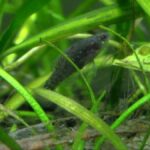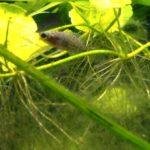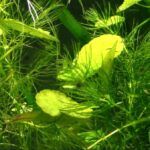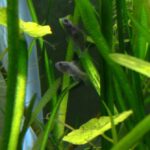Clear sluggish spring-fed stream near Wekiva River, Florida, USA
_st place in Biotope Aquarium Design Contest 2022

Volume of aquarium: 40 L
Dimensions of aquarium: 55.5cm x 27cm x 33 cm
List of fishes: Elassoma evergladei, Physella acuta
List of plants: Sagittaria Subulata, Vallisneria, Hydrocotyle leucocephala, Lemna minor, Ceratophyllum Demersum
Description of Decorations and Substrate: Carribsea Natural Sand was used to create a sandy bottom since these fish spend a lot of time near the bottom. Fluval Stratum was used for the health of the plants.
Description of Equipment: Aqueon QuietFlow LED PRO 10 Aquarium Power Filter, NICREW ClassicLED Light
Water Parameters: Clearwater, Temperature is 20C – 22C, Ph 6.4
Additional Info: Weekly water change 25-30%. The Physella acuta eggs are consumed by the Elassoma Evergladei to simulate their habitat as they hunt for snail eggs and other small crustaceans in the wild.
Aquarium video:
Description of the Area Surrounding the Biotope: This area has many trees and submerged aquatic plants. The water is clear here and has many species of fish that live in various areas of the stream. The wildlife is abundant with many species of wildlife such as West Indian manatee, Florida black bear, wood stork, bald eagle, and sandhill crane. The Wekiva river support extensive floodplains, but also many spring-fed components. This stream is considered subtropical because it has an annual temperature of 22 C.
Description of the Underwater Landscape of the Biotope: These fish reside in swamps, sphagnum bogs, sloughs with heavy vegetation, canals, overflow pools, ponds, lakes, and streams; generally over mud, silt, sand, limestone, or detritus.
Description of the Habitat Parameters: Temperature is 10C -30C, Ph 6-8, Water Hardness 3- 15 d
List of Fishes and Invertebrates Occurring in the Nature Biotope: Micropterus salmoides, Lepomis auritus, Lepomis macrochirus, Physella acuta
List of Plants Found in the Nature Biotope: Utricularia purpurea, Myriophyllum laxum, Myriophyllum heterophyllum, Utricularia floridana, Sagittaria Subulata, Vallisneria, Hydrocotyle leucocephala, Lemna minor
Threats to the Ecology of the Biotope: Land development, siltation, and hydrologic alterations such as channelization and construction of impoundments are a threat to this species.
Sources of Information:
• “Everglades Pygmy Sunfish (Elassoma Evergladei).” Everglades Pygmy Sunfish (Elassoma Evergladei) – The Free Freshwater and Saltwater Aquarium Encyclopedia Anyone Can Edit – The Aquarium Wiki, http://theaquariumwiki.com/wiki/Elassoma_evergladei.
• ERSS – Everglades Pygmy Sunfish (Elassoma Evergladei) – FWS. https://www.fws.gov/fisheries/ans/erss/uncertainrisk/ERSS-Elassoma-evergladei-FINAL-November2017.pdf.
• “Everglades Pygmy Sunfish.” Outdoor Alabama, https://www.outdooralabama.com/pygmy-sunfish/everglades-pygmy-sunfish.
• Tessdale, Michael. “Fish in Focus: Everglades Pygmy Sunfish, Elassoma Evergladei.” Eevergladei in Focus, https://www.nanfa.org/fif/Eevergladei.shtml.
• “Elassoma Evergladei Summary Page.” FishBase, https://www.fishbase.se/summary/3364.
• “Everglades Pygmy Sunfish.” Florida Museum, 7 May 2020, https://www.floridamuseum.ufl.edu/discover-fish/florida-fishes-gallery/everglades-pygmy-sunfish/.
• Thenativetank. “The Peaceful Pygmy Sunfish, Family Elassomatidae.” North American Native Fishtanks, 19 Apr. 2015, https://thenativetank.tumblr.com/post/116759767921.





